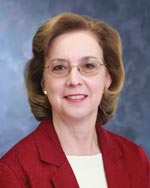 Janet Buckingham is a staff analyst at Southwest Research Institute in San Antonio, Texas. She works with teams of engineers, scientists, and analysts by applying statistical techniques to solve problems benefiting government, industry, and the public through innovative science and technology. For more than 27 years, she has volunteered on ASA chapters, sections, task forces, and committees. She currently serves on the ASA Board of Directors as a Council of Sections representative.
Janet Buckingham is a staff analyst at Southwest Research Institute in San Antonio, Texas. She works with teams of engineers, scientists, and analysts by applying statistical techniques to solve problems benefiting government, industry, and the public through innovative science and technology. For more than 27 years, she has volunteered on ASA chapters, sections, task forces, and committees. She currently serves on the ASA Board of Directors as a Council of Sections representative.
The concept of volunteering is in vogue again. People volunteer or give back in all sorts of ways—United Way, Boy/Girl Scouts, helping the disadvantaged/homeless/hungry, church organizations, and other community service areas. But have you ever thought about how you can volunteer for a professional organization, such as the ASA?
Are you a student or young professional just getting started in your career as a statistician? Volunteer opportunities within the ASA are just as diverse as the reality and game shows on TV. Based on my experience, I will share insights and tips to help you surf to the right channel of volunteerism.
Odds Are in Your Favor
Join a Chapter. This is a great place to start volunteering if you happen to be near one of the 72 ASA chapters located around the country. This is how I first became involved in the ASA. I joined the San Antonio Chapter and quickly began helping to develop our local newsletter (this is a great way to meet the chapter officers and other chapter members). I met several local statisticians who gave talks on the work they were doing.
Chapter dues are typically very low, $1.00 or free for students. Chapters have a variety of activities you can easily pursue—help with chapter meetings, become a webmaster or Council of Chapters traveling course coordinator, judge a science fair, or mentor at a school. Two projects sponsored by the ASA that your chapter can become involved in include the Poster Competition and Project Competition and U.S. Census at School Program for grades 4–12.
Look for an ASA Committee. There are more than 50 committees within the ASA that cover a broad range of activities. Most are organized within four councils of the ASA—Awards Council, Education Council, Membership Council, and Professional Issues and Visibility Council.
Committees typically consist of six to nine members, each serving three-year rotating terms. There are different levels of commitment and service for each committee, and it is a great way to help the ASA in an area of interest to you. All committee members are appointed by the ASA president-elect.
I suggest you look through the committees listed on the ASA website, read their charge of activities and goals, and click the link to volunteer or recommend a colleague for service on a committee if you find one of interest to you. Be sure to indicate the experience you have that would be relevant to the committee or any other comments about why you would like to serve.
Perhaps you have an interest in an education area, career development, ASA membership, law and justice statistics, or professional ethics. All of these areas are important to the ASA as a profession. So, dial in to the ASA website and see what committees spark your interest.
Search for a Section. Just like searching for contestants on the Next Food Network Star, looking for a section could be as simple as defining your favorite ingredient. What are your statistical interests? With 25 ASA sections covering more than 20 sub-disciplines, you are sure to find a section that fits the recipe.
Any ASA member can join a section; they are not related to a particular geographic region. Most sections hold business meetings at JSM every year, but all are busy throughout the year working on areas/activities to serve their members. How can you volunteer in a section? Sections look for ways to grow their membership—publish a newsletter, maintain a webpage, organize best presentation/poster awards at JSM, develop webinar series, organize contributed and invited sessions at JSM, elect officers, and help students with travel awards or paper competitions. Many sections sponsor short courses or other educational activities.
Getting involved with a section was one of the best ways I found to volunteer within the ASA. It has helped me network with other colleagues throughout the country who share the same statistical interests. Yearly section dues are typically < $10, and you can join a new section for the first year free!
Connect with an Outreach Group. Outreach groups involve members who have common interests that are not in the traditional chapter or section structures. Currently, the ASA has four outreach groups: (1) Caucus of Academic Representatives, (2) Friends of Australasia, (3) Statistics Without Borders, and (4) Isolated Statisticians.
Statistics Without Borders provides pro bono statistical consulting and assistance to organizations and government agencies in support of these organizations’ not-for-profit efforts to deal with international health issues (e.g., the earthquake impact on Haiti). Isolated Statisticians consists of academic statisticians who discuss statistical issues with one another because they may be the only statistician within their own educational environment. If you happen to be a young professor within a small department, this group may be beneficial to you.

One of the most active committees I served on was the Advisory Committee on Continuing Education. This committee helps organize the Continuing Education courses at JSM and interfaces with the ASA Center for Statistical Education. Needless to say, this committee is always active. We all had plenty to keep us busy while we looked for ways to improve the courses and help the presenters provide a good experience for ASA members.
The ASA is full of talented people who are eager to help you find the right place for your skills and talent. Everyone has something to give, everyone has something to share, and everyone has something to learn. So, turn off the TV, get off the couch, and volunteer!
Find, Be a Mentor
If you are a student or young professional, it would be wise to seek out someone to be your mentor. If you want to become more involved in the ASA, then find someone already involved in the ASA who can answer your questions and guide you through the myriad volunteer opportunities to maximize your service. Maybe someone within your school or organization is perfect in this role.
You also can be a mentor to others. If you are already involved in the ASA, then seek out young statisticians in your chapter, sections, or committees and help them find their niche. ASA Past President Nancy Geller wrote in her June 2011 President’s Corner column, “You’re never too old or too experienced to look for new role models. And you’re never too young to be a role model for someone else.”
Benefits
The weakest link in your career development may be you. What can volunteering do for you? It can give you the opportunity to practice important skills used in the workplace such as teamwork, project planning, organization, and communicating. You develop a network of statisticians with similar interests. What can it do for others? They can learn from your skills and knowledge. All these opportunities are good for your professional development. I have made lifelong contacts with statisticians I have worked with on committees, chapters, and sections.




Leave a Reply